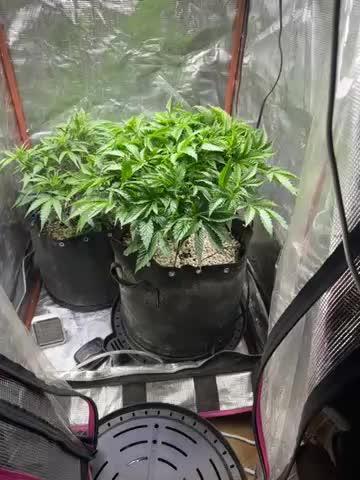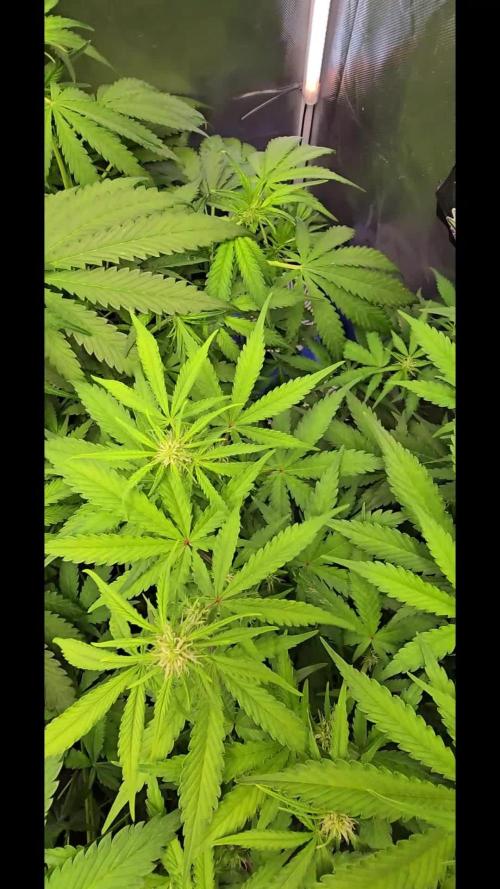The Grow Awards 2026 🏆 

































Likes
Comments
Share


@Nicogreen
Follow
Fuldstændig vanvittigt der har været så meget stress at jeg har haft glemt hende her hun har det satme sygt godt nu takket være dygtig brug af gødning plus at jeg ikke har haft overvandt. 😉. MEN JEG HAR jo stadig lang vej til den færdig
Likes
200
Share


@Hydro_Hiebs
Follow
Hello and thank you for stopping by, it is now day 28 in 2x4 closet and things are going very smoothly I'm watering still with a pH of 6.5 when dry. I'm having minor issues with Gnat larvae in my coco and I am going to solve the issue by watering with neem oil for the next couple weeks. I will also be trying out some hydrogen peroxide in my water at a 4:1 ratio if the neem oil fails to control the larvae. My first top dress will be in about 7 days and I am going to be doing some low stress training this week stay tuned ☺️
Likes
7
Share


@BongRip
Follow
Due to the low yield and really fast veg time, I would avoid this strain until I master the nutrients I am giving the my plants. I only weighted the small plant which is 12g. The strain tastes so good and smooth. I love the quality of the smoke!
Likes
27
Share


@w33dhawk
Follow
03.08.21 Moin Growmies hab mir in der letzten Woche Gedanken gemacht zu meinem Vorhaben mit den Tomatenringen und mir ist aufgefallen das die Ladys nicht Grad gleichmäßig wachsen ,das liegt sicherlich daran das ich Depp wieder schlauer sein wollte und ein paar Seitenäste dran gelassen habe sprich beim ersten topping hätte ich alles entfernen sollen bis auf die 2 Triebe von der 3. Nodie und ich hab die 2 nodie mit stehen lassen weil ich dachte ich bin schlauer 🤬🤬🤬🤬🤬🤬🤬🤬🤬🤬🤬🤬🤬🤬🤬🤬🤬🤬🤬🤬ich könnte mich selber schlagen für die Dummheit naja Ergebniss des ganzen ist ungleichmäßiges Wachstum somit kann ich die Sache mit den Tomaten Ringen vergessen.......... Hab jetzt aber mein System noch einmal überarbeitet andere Topferhöhung ( 2x alte Bilderrahmen aus Holz auf Paletten Balken geschraubt und mit Hühner Draht bespannt das ganze auf Steine gestellt damit ich ne Wanne darunter stellen kann für abtropfwasser) den Rahmen vom scrogg netzt wieder raus gesammelt und neu bespannt ( Rahmen
90x90 cm aus nem alten Pavillon Gestell zurecht gesägt und mit Zaun bespannt die Abstände zwischen den einzelnen Rauten beträgt 6 cm sollte ausreichend Platz für die Triebe sein) habe das ganze gestern auf einer Höhe von 16 cm über dem Topfrand eingebaut mit Kabelbindern an den Zeltstangen befestigt somit hängt es an seiner Position fest und kann nicht von den Pflanzen hoch gedrückt werden wenn sie in die Blüte geht. Also is nun doch wieder ein sqrogg draus geworden aber den Ladys geht es insgesamt gut sie wachsen und gedeihen und wirken insgesamt gesund in den nächsten Wochen werde ich nun die Ladys in das netzt weben und Mal sehen was sie von scrogging Alla Milchschnitte halten.
Ach ja die purps aus dem Garten sind anscheinend direkt nach dem umtopfen in den Stretch zur Blüte gegangen war ein bisschen spät dran fürs raus setzten
aber lässt sich jetzt nicht ändern Mal sehen was draus wird,vll ja ein Gummibärchen Baum 😏😉 hab den outdoor Ladys gestern nen kleinen Regenschutz gebaut, is nicht der schönste aber er sollte seinen Zweck erfüllen damit der Topf Mal abtrocknen kann das Wetter ist seit fast 14 Tagen hart wechselhaft und der Topf noch nicht 1x richtig trocken gewesen das war's eigendlich was bis heut passiert ist cu Growmies und euch noch viel Erfolg........
Processing
Likes
6
Share


@Flydope21
Follow
Week 2 veg. Starting some LST this week. Pretty new to this so hopefully all goes well!
Processing
Likes
6
Share


@Syntaxx1313
Follow
Today marks week 9 of the red poison auto flower. I started the flushing process this week. The Trichomes were starting to get milkiy on week 8 so I decided to flush the plant since I am looking for 65 to 80 % of milkiy for my final product. I am going to flush for 2 week for the best results (in my opinion) since the medium I am using is soil.
Instead of feeding her nutrients on October 16 2019 I just gave her the 1.5 gallons of PH(FOR SOIL 6 - 6.8) water with molasses.. I checked the run off water and the PH was 6.8 and my PPM was high at 1336. So on October 19 2019 I did a extreme flush of my auto in a 7 gallon soil pot. (I have tried flushing with certain agents in the past but from my experience and opinion I feel that flushing with just PH water works fine.) Well I flushed the plant down from 1336 to 336. I would have preferred a PPM level below 200 but the water I am using has a PPM level of 270. I actually ended up using 18 gallons of PH water to flush the plant in order to bring the PPM down from 1336 to 336. The PPM kept kept going down and then back up again after every flush so I had to keep adding gallons of water in order to make sure that at least half of the nutrients were washed from the soil. From this point on I will no longer feed her nutrients. I will just give her the regular amount of PH water I've always given her except the only difference is that I will no longer add nutrients to the water. The only thing I will add is molasses in the PH water in her regular feeding schedule. I am hoping to harvest around the 26 of October.
Likes
33
Share


@TeknoRanger
Follow
🌱 Sour Apple⠀⠀⠀
🌸 flowering 9 weeks⠀⠀⠀⠀⠀⠀
💚 70% Indica, 30% Sativa⠀⠀⠀⠀⠀
💣up to 27% THC⠀⠀⠀⠀
👅Apple, lemon⠀⠀⠀
⚖️ 550g/m²⠀
Sour Apple was created by an intersection of the original Sour Diesel and a Pure Kush. It is an indica dominant hybrid with a combination of both indica and sativa effects. It has an delicious intense taste of sour apples and lemon and a gigantic potency.
The rockhard buds are covered in a thick layer of milky white trichomes and are packed with sweet resin. Users describe the high of the sour Apple as a strong mental shift, a uplifting head high that leaves you motivated and focused with a sense of overwhelming euphoria and social tendencies. This is followed by a slow fade into an intensely overwhelming couch-lock. Sour Apple sends her 27% of THC stright to your mind to kick you in other psychedelic spheres. We proudly present this unique goddess to all the growers in the world.
GROWING SOUR APPLE
When growing indoors it is a good idea using screen of green or sea of green methods. You can expect big yields of 500g or more per squae meter indoors, 700g per plant outdoors. The flowering time is 9-11 weeks. Indoors, Sour Apple is a vigorous grower with many side stems which can be trimmed to keep the plant in bounds. Indoors, the plants grow between 1,00-1,50 m depending on the introduction of the flowering phase, outdoors Sour Apple can reach four metres of hight.
MEDICAL USE
Because of its strong effects Sour Apple is an ideal strain for treating patients who suffer from conditions such as chronic stress or anxiety, chronic pain due to injury or illness, and sleep disorders (insomnia and sleep apnea). In low doses it is daytime suitable for medical applications, at higher doses, it is the ideal weed for medication at the evening.
Likes
14
Share


@Hempface86
Follow
All right guys here we go today is day 47 and she has grown a couple inches in the last week but she has now transferred her energy into stacking.. I will say this plant is showing a lot of ruderalis traits I'm not expecting it to be the strongest smoke trichome production is at a minimal but the end result can be great who knows time will tell.. big thanks to Sensible Seeds for the opportunity to grow this girl and if you guys are looking for great seeds huge huge variety of over a couple thousand strains if not a few thousand and have great deals on bulk seeds name brand breeders too.. I hope everyone is doing well and so is there ladies God bless and happy growing to everyone ✌️✌️
https://www.sensibleseeds.com/
Likes
53
Share


@XG_Jack
Follow
It was great all the way through. 10 stars… This grew into a really stellar plant and it took all of those qualities through harvest.
One of my best grows to date.
Likes
40
Share


@Dingle
Follow
Week 4 flower 🌸
Both plants seem healthy and happy so far showing good bud development this week.
I have been giving both plants around 500ml of water each in between feeds as the pots are drying up every couple of days.
some light defoliation removing a few leafs that were blocking some of the larger bud sites.
✌️
Likes
1
Share


@803AutoGrower
Follow
So this week I topped every branch on my gopher glue and in Les than 48 hours she looked like she was in overdrive with new growth everywhere defoliated a few spots and she showed no signs of slowing at all. Tied down my branches on my fog hound auto as she showed signs of hitting her stretch and she had responded well to anything I’ve done to her. Really really pleased with these genetics from atlas seeds so far. Got quite a few more from them to run but don’t have access to the space at the moment but definitely wanna play around with some of their stock. This gopher glue is massive considering her age and how cold it’s been here even before the topping her lateral branching was insane and her growth structure has been squat and dense a bushy. I’m almost tempted to keep her in veg until early march and put her in the ground to take advantage of the high intensity of full sunlight. Outdoors in my location during the late spring I’ve had plants grow 4 inches a day almost so maybe I do this but maybe I just glowed her and run another outdoor this coming season. Let me know what you all think. Is this a bad idea
Likes
38
Share


@420DeepGrow
Follow
Gracias al equipo de Anesia Seeds, Marshydro y XpertNutrients sin ellos esto no seria posible.
💐🍁 Purple Lobster:
Con un 34% de THC, Purple Lobster no es ninguna broma. Cada calada es una explosión de arándanos, caramelo y sabor afrutado que hará que tus papilas gustativas surfeen sobre las olas del sabor. Es como sumergirse en una piscina de las vibraciones más frías y sabrosas que puedas imaginar.
Puede que en Maine se haga bien la langosta, pero en Anesia Seeds hacemos cannabis como nadie. La Blue Lobster ya causó sensación con sus tentadores terpenos y su atractivo en bolsa que se sale de lo común. Ahora, mézclala con el dulce y jugoso aroma afrutado y las notas mentoladas de Planet Red, y tendrás Purple Lobster , una variedad que no sólo se fuma, sino que es toda una experiencia.
🚀 Consigue aqui tus semillas:
💡FC6500: Eficiencia líder en el mercado: la lámpara de cultivo LED FC-E6500, que ostenta un estatus líder en el mercado, es una solución rentable con un PPE de 2,8 µmol/J y un rendimiento máximo de 2,5 g/vatio. Ofrece un PPF alto de 2026 umol/S y es adecuada para una cobertura de vegetación de 1,50 m x 1,50 m y una cobertura de flores de 1,20 m x 1,20 m.
Iluminación versátil y uniforme.
https://marshydro.eu/products/mars-hydro-fc-e-6500-730w-commercial-led-grow-light/?gad_source=1&gclid=Cj0KCQjw1qO0BhDwARIsANfnkv9IIrYSbmJqz8PqpJOIyWwJfp5bc3SGJgUV68USLQ4tjmXDYwoBuAsaAue3EALw_wcB
🚥 MarsHydro ADLITE UV/IR/RED:
Para lograr un crecimiento óptimo de las plantas y maximizar los rendimientos es un arte simple que depende en gran medida de las condiciones ambientales adecuadas. Reconociendo las limitaciones de la iluminación natural y las soluciones de iluminación tradicionales para satisfacer estas necesidades únicas, lanzamos ADLITE. Estas luces especiales UV, IR y roja están diseñadas para llenar áreas del espectro, proporcionando las altas longitudes de onda que las plantas necesitan para un crecimiento y desarrollo óptimos.
🚀 Consigue aqui tu Adlite:
https://marshydro.eu/collections/adlite-supplemental-lights/
🏠 : Marshydro 1.50 x 1.50 x 1.80, carpa 100% estanca con ventanas laterales para llegar a todos los lugares durante el grow
https://marshydro.eu/products/diy-150x150x200cm-grow-tent-kit
🌬️💨 Marshydro 6inch + filtro carbon para evitar olores indeseables.
https://marshydro.eu/products/ifresh-smart-6inch-filter-kits/
🍣🍦🌴 Xpert Nutrients es una empresa especializada en la producción y comercialización de fertilizantes líquidos y tierras, que garantizan excelentes cosechas y un crecimiento activo para sus plantas durante todas las fases de cultivo.
Consigue aqui tus Nutrientes:
https://xpertnutrients.com/es/shop
📆 Semana 14:
Última semana de lavado de raices antes de cosechar esta maravilla, ha quedado una planta con unos cogollos escarchados y muy prensados, su dulce aroma te taladra el cerebro .
Likes
21
Share


@w33dhawk
Follow
Moin moin liebe growmies diese Woche war wieder ziemlich gut ich hab eine Lady bei der ich den Verdacht habe das sie einen tabacmosaikvirus hat werde die komischen Flecken weiter beobachten, da ich nach der ersten gabe von guano Grow das Gefühl habe, sie füllt die Flecken mit grün aus ( konnte ja auch ein Nährstoff Defizit sein)
16.04.22 heute gab es nährlösung 300 ml (extract, bat boost und microbes, Ph 6,5)
17.04 und 18.04 am Wachstum erfreuen
19.04.22 wieder giessen 500ml diesmal reines Wasser ( Ph 6.5) die Ladys sind durstig
20.04.22 zuschauen und am Wachstum erfreuen Ach ja und die wurzel Masse im Topf kontrolliert ist gut voll gewesen weshalb ich mich entschieden habe in dieser Woche noch um zu Töpfen (wollte eigendlich erst in Woche 4 umtopfen) aber die Flecken an dem neuen Wachstum sahen für mich im ersten Moment aus wie Nährstoff Mängel da war handeln angesagt
21.04.22 heute war Tag des umtopfen's habe meine 4 Ladys die im Zelt bleiben sollen in 8l stofftöpfe eingesetzt (sind zwar 8l stofftöpfe da sind aber ca 12-13L Erde die da rein passen bis der Topf voll ist) sollten sicherlich reichen wenn ich 8 bis 10 Wochen vegi fahre. Angegossen habe ich das ganze mit 500ml nährlösung ( extract, bat boost, grow und microbes)
22.04.22 heute war nur zu schauen und beobachten wie sich das Problem kind entwickelt, für nächste Woche steht dann endlich topping an freue mich schon total endlich mit den Ladys zu arbeiten zu können
Euch noch ein schönes Wochenende und erfolgreiche ernten cu growmies
Update: Habe meinen kleinen Eimer zum Wasser aufbereiten ausgetauscht ist jetzt eine Oscar Tonne 23L Fassung Vermögen, ca 20 L wasser drinnen 2x Sprudel stein,eine aquarium Heizung und den Deckel habe ich mit löchern versehen. Die Schläuche für die Sprudel Steine habe ich am oberen Rand durch gezogen also auch dort jeweils gegenüber liegend ein Loch gebohrt damit der Deckel sie nicht ein quetscht.Wie in dem video zu sehen ist,sind die Löcher im Deckel damit das wasser vernünftig aus dünsten kann wegen dem chlor was enthalten sein kann da es ja aus der normalen Haushalts leitung kommt. Das ganze läuft 24/7 h und wird ca alle 14 Tage aus gewechselt und gereinigt
Likes
101
Share


@Ferenc
Follow
Day 65, 17th of November 2020:
Welcome back at the beggining of the 3rd week of flowering. They seem to be stopped streching and now concentrating on buds.
All of them are gorgeous.....
The 2 Zamnesia genetics Gelato and Kalini Asia are pretty and buds are forming nicely. Kalini Asia might strech a bit more but not long.
The Sweet Seed ones are really nice and I am so happy because Red Hot Cookies is already getting red.... pistils and around the leaves.. I hope the same happens to the Red Mandarine and Tropicanna Poison also. They are so gorgeous. They calmed down I don't expect more strech.
Fertilization still the same every 2nd day with the ratio and mix above.
Some lollipopping (Defoliation) is also done.
I removed all the LST the plant remains in the same shape from now.
The lamp is on 11.30 min and off 12.30 min.
Last week was 15 min longer light cycle....
So every week 15 min shorter light cycle until the 5th week. So far -30 min. It switches on at 6 am and off at 17.30 pm.
Likes
107
Share


@Tropicannibis_Todd
Follow
ALRIGHTY THEN GROWMIES 😎
👉SHES PRETTY MUCH READY JUST WANT MORE AMBER👈
We just hit week 13 and all is well , have to admit she's just killing it super happy with how shes coming along 😃 ....... Just waiting on her to ripen up 👈
👉Had to bring out the Bamboo sticks a few week ago as she's putting on the weight 👈
And she's filling out the pot perfectly👌 Lots of tops 👈
👉NutriNPK NUTRIENTS USED FOR FEEDING 👈rain water to be used entire growth👈
👉www.nutrinpk.com right now get 10% off using SPRING2022 as the coupon code👈
Lights being readjusted and chart updated .........👍
I GOT MULTIPLE DIARIES ON THE GO 😱 please check them out 😎
👉THANKS FOR TAKING THE TIME TO GO OVER MY DIARIES 👈
Likes
8
Share


@Herbman420
Follow
Hi everyone i just put the seed in today . I'm running it with Coco perlite and xpert nutrients will do updates in the week to keep you informed. Thank you for looking at the diary and a remember it's 420 somewhere 🌱
Likes
8
Share


@DeepRootsGrowTrees
Follow
Week #9 Baby Boom/Kannabia Seeds
Week #9 Dec.23rd-Dec.30th
Baby Boom Week #9 plant is looking good buds are continuing to grow and get dense thricomes have started to become more visible. She's just a nice looking plant. She grows like a sativa with her stretch and bud structure. Thank you for taking a look!!
Stay growing great Medicine this year!!

























